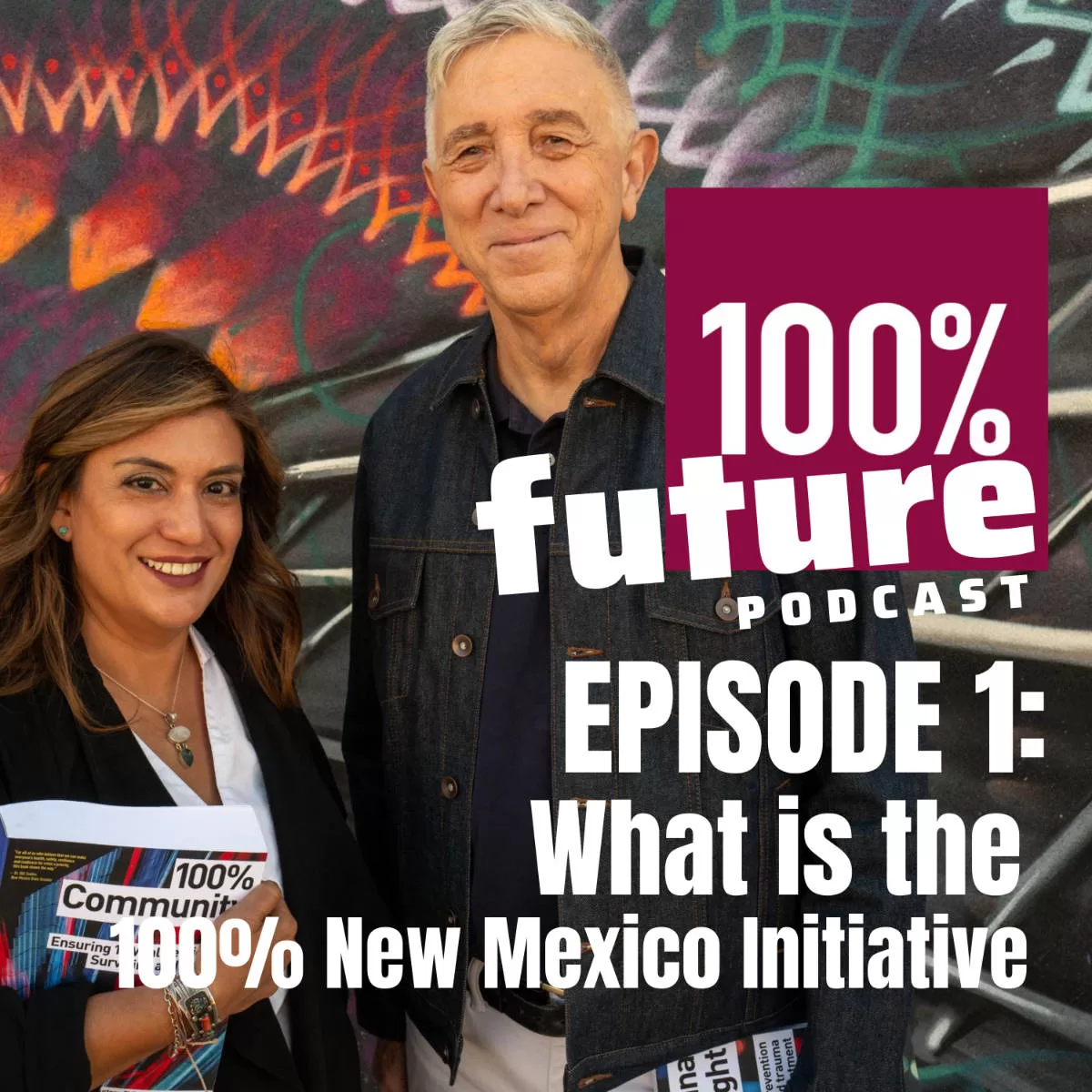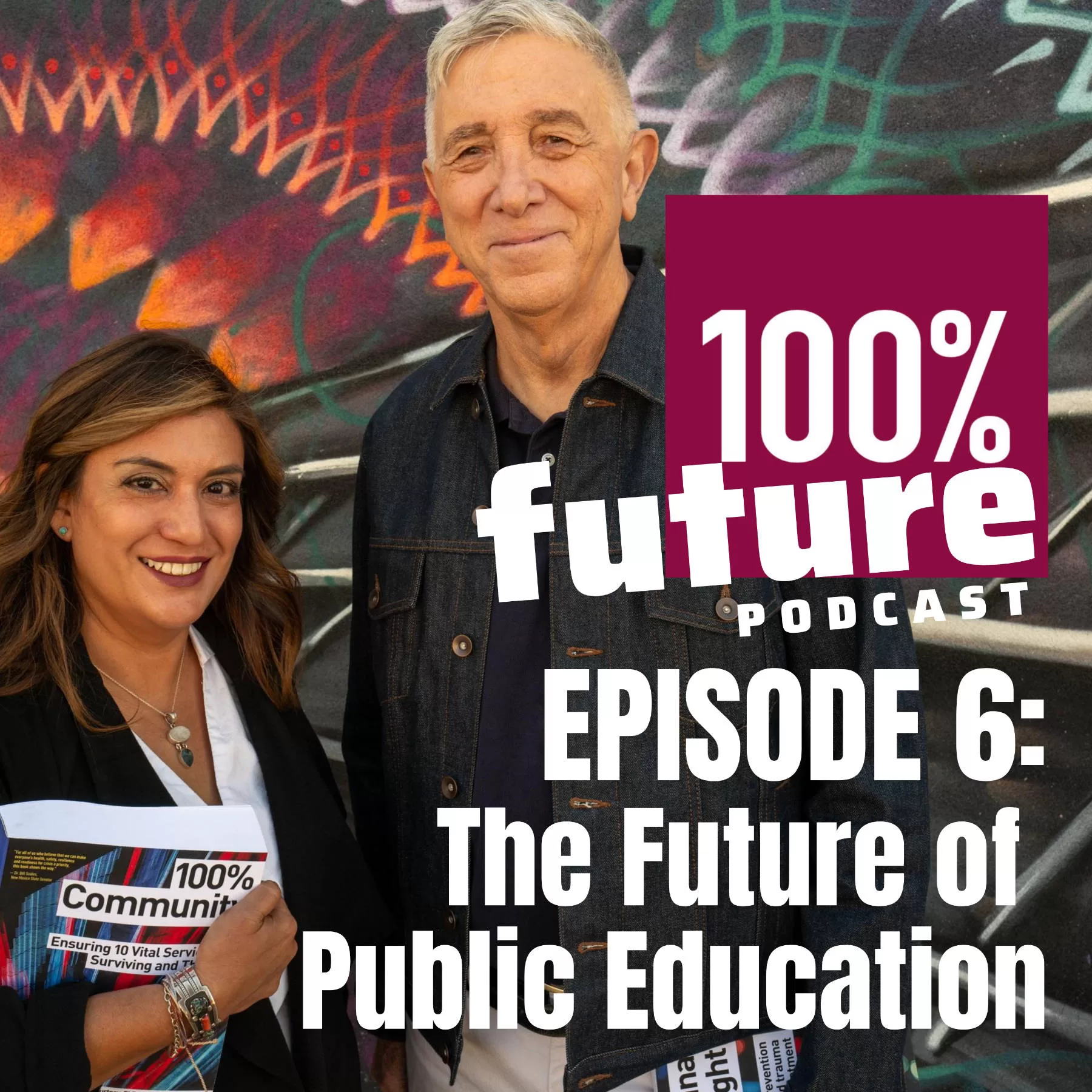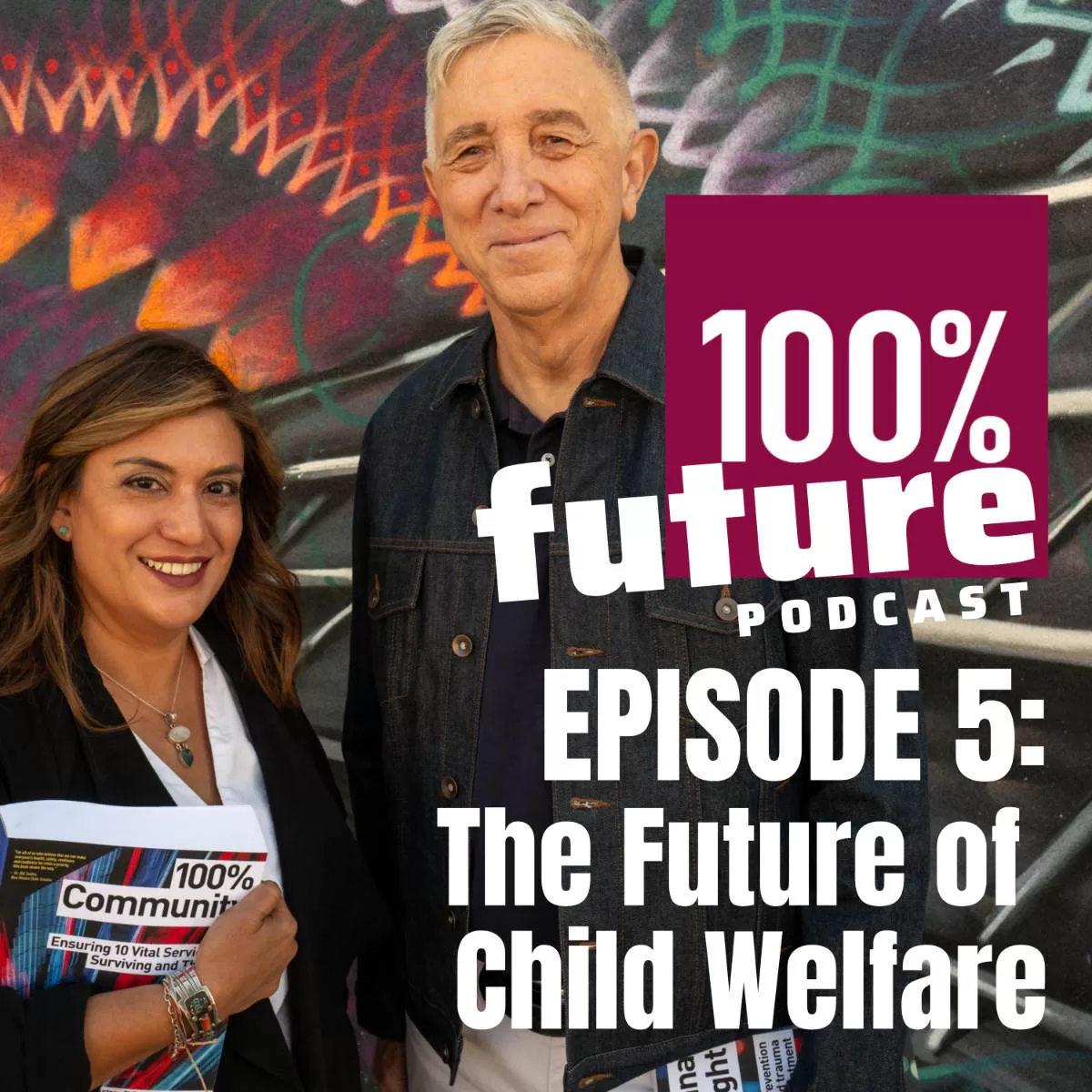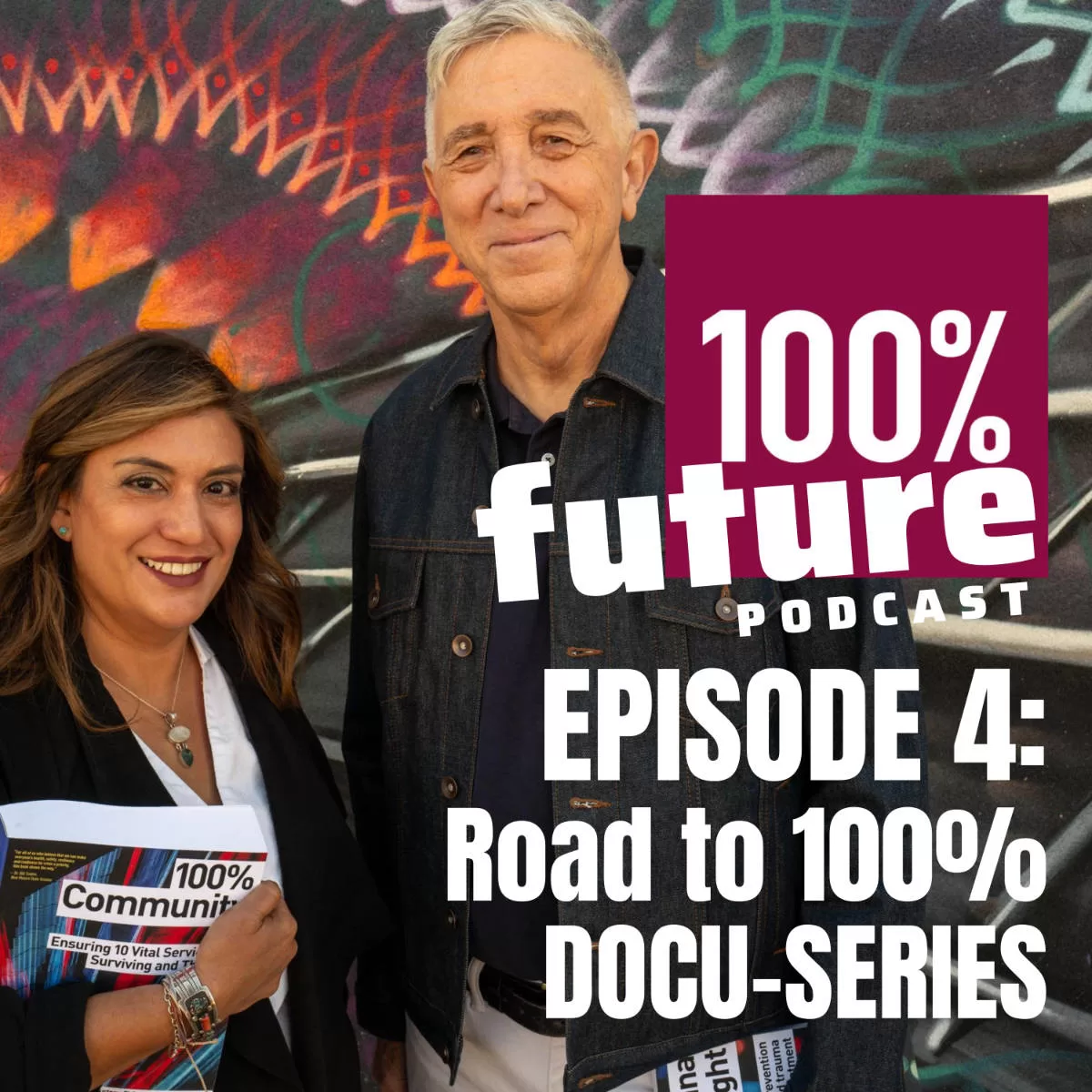Episode 1: What is the 100% New Mexico Initiative
In the first episode of our podcast, host Rubina Cohen sits down with Dr. Katherine Ortega Courtney and Dominic Cappello to unravel the heart-wrenching experiences they faced while working within the New Mexico Children, Youth, and Families Department (CYFD), experiences that propelled them towards an unwavering mission for change. The trio delves into the catalyst for their transformative book, Anna Age Eight, shedding light on the urgent need to overhaul the child welfare system. Their candid conversation reveals how this tragedy spurred the creation of the Anna Age Eight Institute, setting in motion a movement for comprehensive reform aimed at safeguarding children and empowering communities.
Join us as we journey through the birth of the 100% New Mexico initiative and its profound impact on communities across approximately 20 counties in New Mexico. Katherine and Dominic share their insights on implementing seemingly simple yet remarkably effective solutions, emphasizing the importance of delivering ten vital services to 100% of New Mexicans. Through this episode, we aim to illuminate the path towards a New Mexico that thrives, where every individual not only survives but flourishes, driven by a collective commitment to provide essential services to all.
Introduction:
Welcome to Episode 1 of our podcast, where host Rubina Cohen is joined by Dr. Katherine Ortega Courtney and Dominic Cappello to discuss the 100% New Mexico initiative and its profound impact on communities.
The Catalyst: CYFD and Anna Age Eight
Discussion on their experiences at CYFD and the traumatic event that propelled them to write the book “Anna Age Eight,” shedding light on the urgent need for change within the child welfare system.
The Birth of Anna Age Eight Institute
Exploring how their book became the catalyst for the Anna Age Eight Institute, aiming to transform systems and create a safer environment for children through comprehensive approaches.
Spreading Solutions through Collaboration
Sharing insights on the expansion of their work to approximately 20 counties in New Mexico, emphasizing the simplicity of solutions and the power of a book club to initiate change and empower communities.
The 100% New Mexico Initiative and the Ten Vital Services
Delving into the ten vital services critical for 100% of New Mexicans, highlighting how focusing on these services can lead to a thriving New Mexico and discussing the initiative’s impact on communities.
Conclusion:
Encouraging listeners to learn more, engage with the initiative, and become a part of the movement towards a New Mexico that is not just surviving but thriving through the 100% New Mexico initiative.
Podcast Transcription
Relevant Links:
- American Journal Of Preventive Medicine – ACES Report by JV Felitti, MD:**
Read the ACES report - Anna Age Eight – Free Download for all New Mexico residents (also available on Amazon):
Download Anna Age Eight for Free - “100% Community” – Free Download for all New Mexico residents (also available on Amazon):
Download the “100% Community” Book for Free
Episode 1 Transcript
Transcript edited for clarity.
Intro [00:00:01] There’s no reason for people in a society as wealthy, resourced and technologically advanced as this one, to not be thriving. Every crisis we are exposed to hourly is completely predictable and preventable if we connect to a shared vision of everyone thriving, surviving the day is just not acceptable anymore when we know that thriving is actually possible. Welcome to the 100% Future podcast, where Dr. Katherine Ortega Courtney, Dominic Cappello and me, Rubina Cohen as your host, share insights, action plans and inspire you weekly to take bold action in designing thriving communities for all.
Rubina Cohen [00:00:49] Welcome back, everyone, to our first episode of the 100% Future Podcast. As you know, our last episode was our pilot episode, and technically this is our first episode and we have a really important and integral topic to jump into today. It really is the foundation of all the work and why this work is being laid out with my colleagues Dr. Katherine Ortega Courtney and Dominic Cappello back in the studio to jump into this important topic today. Welcome. Welcome back, guys.
Katherine & Dom [00:01:35] Hi. Good to be here.
Rubina Cohen [00:01:38] All right. So today we really want to dive into ACEs (adverse childhood experiences), and the adverse childhood experiences survey, and what this (the survey) is exactly and how this (ACEs) has been what shapes what the 100% New Mexico initiative is all about. So I’m going to let either of you, who wants to jump into this important topic first?
Dr. Katherine Ortega Courtney [00:02:11] I want to tell the story about how I learned about ACEs because it was a game changer for me. So, I was working for Juvenile Justice here in New Mexico at the Children Youth and Families Department. I distinctly remember I was sitting in my little cubicle. It was after five. I was working at a flex schedule at that time and I saw this email and it was like one of those eblasts, you know, like, “Oh, this new research paper came out” and I clicked on it and it was (clear that) adverse childhood experiences are connected to basically everything. And I was like, “What? You know, this is what I’ve been looking for as a researcher in Juvenile Justice.” How do kids end up in the system? How do they end up in (child) protective services? And, basically it said we can predict what’s going to happen in adulthood based on what happens in childhood if these ten things happen. And I’ll let Dom talk about each of those ten things (ACEs). But to me, it was like this lightbulb going off. I had been doing research on trauma and I had noticed these patterns of kids in New Mexico in Juvenile Justice. All of them had traumatic events happen and this research put it all together in just such a concrete way. And then when I realized this research had come out, you know, decades before. Wow. It was like, why are we doing this? Why don’t we concentrate on this? And I sent it to all of my colleagues, everybody in Juvenile Justice. I (said), “This is the key. This is the thing.” If we can prevent these, we can change the game. And of course, as you know, the story of getting here is a long way from that. But (for) me, This research was absolutely what I had been looking for as a researcher, as a psychologist, this is the key to why people struggle with substance abuse, crime, all of the things that we’re trying to prevent. And this research had come out in, I think, 1997, something like.
Dominic Cappello [00:04:25] 1998.
Dr. Katherine Ortega Courtney [00:04:26] Yeah.
Rubina Cohen [00:04:27] Wow. So I keep saying, wow, because, you know, I felt the same way when I first learned about and took the survey myself. So what was their reaction? What was it when you sent it (information on ACEs) to all your colleagues when you were (thinking), “Why aren’t we focusing on this?” What was the reaction?
Dr. Katherine Ortega Courtney [00:04:46] Deafening silence. Yeah. I mean, some people were like, “Oh, yeah, you know, that’s cool. But, you know, we’re doing this.” (Or) “We don’t have time to shift what we’re doing” or “That’s not our job. We’re here to intervene once things happen. It’s not our job to prevent things. That’s a different department. That’s the Department of Health or someone else. But yeah, nothing was done based on that until seven years later when we started the Anna, Age Eight Institute.
Dominic Cappello [00:05:23] Right. I guess I would say that I remember getting an email from a nonprofit in Seattle, and it said that they are addressing adverse childhood experiences, and I thought, wow, that’s really interesting. I was working for the State (government), the New Mexico State Department of Public Health at the time, and I read the description of the program this nonprofit had. They were describing the study that was done by Dr. Filetti and team decades ago, the study that looked at the adverse childhood experiences of adults. So this study looked at adults, asking them, “(thinking) back to your childhood what did you experience?” And to be clear for our listeners this list of ten adverse childhood experiences, it’s pretty hard to hear if you’re imagining our children enduring these every day. But the list would be physical abuse, emotional abuse, sexual abuse, physical neglect, emotional neglect, living in households where adults have substance use disorders, or adults are engaged in domestic violence or have untreated mental health challenges, parents may be divorced or separated or a family member is incarcerated. So as you listen to that list, I think that honestly, I think our brains have a hard time processing that. I mean, to take all that in as if that’s your life…if you’re an eight-year-old and that’s what’s happening now. The study was significant because it looked at what happened to you in childhood and then what happened to you in adulthood. They wanted to see if (ACEs) would have any impact in terms of your physical health or your emotional health. And of course how could that not impact your life? So that’s how I first heard about it, getting the description, learning about the study. I could talk a little bit more about my concerns about their (the Seattle nonprofit’s) particular prevention process. I had a lot of concerns about what they thought could prevent it (ACEs), but I’ll stop now in terms of just letting our listeners sit with (this information a) little bit about how mortifying it is that our kids, as I’m speaking, are living in households where this is happening.
Rubina Cohen [00:08:12] I know. But I can just say from my own experience I grew up in a family of five kids. I’m one of five children. And we were dealing with potentially nine out of ten of those (ACEs). And so really not having access to solutions or services and having to be resourceful on our own and becoming adults at a very young age because the adults in our lives didn’t know how to address those as well. And then…lacking communication, parents lacking communication on how to talk about some of these things and cultural restraints in how to talk about some of these things. Not even having an environment where you can just share that this (ACEs) is going on. It’s a lot, it’s a lot to deal with and bear. I would like to say my particular personal circumstance, things have turned out quite well in my life. I’m so grateful for that because I was able to find help and go through that journey and have some support in finding the right people to help me. But, that’s not always, and in many cases, true for a lot of our children in our community.
Dominic Cappello [00:09:53] Right. I’d like to say two things. I’m glad you brought it up. You’re referencing family culture and (the question) are we allowed to talk about these things or are we allowed to ask for help with relatives? And I do remember going to my aunt. Now, this is an Italian-American family, very traditional in many ways. And this was my favorite aunt. And I did bring up the fact that my mom was really struggling with a lot of issues that were leading to ACEs. And her reaction was, “We really don’t talk about those things.” And I can’t tell you how shut down I felt. It would take me years, and I mean decades, to ever feel strong enough to talk to people about what was happening in my own life, with a score of five out of ten ACEs.
Rubina Cohen [00:10:49] Thanks for sharing that. I think that’s probably relatable for so many people. Talk a little bit more about the sort of potential recommended solutions and why they’re just not effective. And then let’s tie that back to the 100% New Mexico initiative a little bit for our audience.
Dominic Cappello [00:11:20] I can tell you that when I saw the prevention strategies from this group out of Seattle, I was coming at it from a place of knowledge in that I was working within the (New Mexico State) Department of Health. I had colleagues who worked in child welfare. I had an understanding of what this (ACEs) would mean and the recommendations from this nonprofit (focused on producing) seminars to talk about it (ACEs) with the adults and providers, and we should make sure that our kids can talk about it (ACEs). Now, there’s nothing wrong with that. Of course, we would like every adult to be talking about it. We would like every healthcare provider and teacher to be talking about it. And we certainly would like to create very safe spaces for young people to share. But, if that’s your only strategy, we’re not going to change the rates of ACEs. I eventually did reach out to this group and I shared that families need behavioral health care and beyond that, they’re going to need medical care and stable housing and food, all of the services for surviving and thriving that make a family healthy and safe and resilient. Their reaction to me was, “Well, we don’t do that. We just initiate seminars (and) that’s really going to be helpful.” And quite frankly, I was appalled.
Dr. Katherine Ortega Courtney [00:13:00] And I had a similar experience working within CYFD. Let me talk a little bit about how CYFD works with families. So calls are made to a central intake, right? Of those calls that are made, (this is a concerned neighbor person, whoever it might be calling to say), “I’m concerned about this kid or this family.” Of those calls, the vast majority are screened out, so nothing is done. Of those that are screened in, those get assigned to an investigator who goes out and determines, is this case substantiated or not. Of those cases, the vast majority (are) not substantiated. So here we have (a problem). This was my frustration working in the department. Families who are clearly, at least at some level, are struggling, have some kind of issues(. They) need some help. Those calls get made and nothing happens until things get bad enough for them to get screened and substantiated. So to me, there was this huge opportunity to get these family (to) services at the get-go. Instead of waiting for things to get so bad that the child is removed from the home and put into foster care. Why? Why wouldn’t we be doing that as a state, as a system? Most child welfare systems operate the same way. It’s an intervention. It’s just like Dom said, “Let’s wait until things are bad and then talk about it or let’s intervene after things have gotten bad.” To me, it was always a huge missed opportunity to like, let’s get people the support and services they need immediately so that things don’t escalate. And that is how you prevent ACEs. It’s not intervening afterwards. I think most organizations have an intervention mindset rather than a prevention mindset and it’s understandable because it’s more tangible to say, “We served this many kids, we have this many kids put in foster care.” You can’t measure prevention as easily and it takes longer. So it’s not as appealing to funders who want to show an impact or legislators who want to be able to say, we did X (people or cases) in my two-year term, things like that. It’s a really (about a) long-term solution and it makes it a lot harder to get excited about because it’s harder to show success. Our initiative is probably a 10 to 20-year initiative, if done correctly, to really show look at this next generation of kids that don’t have ACEs. Now, that’s going to take a while.
Dominic Cappello [00:15:51] I’d like to add that, as Katherine said, you have to have a long-term vision because these problems are huge. But, that doesn’t mean we can’t have significant successes along the way. But the first thing you have to do if you are concerned about ACEs and we should make it very clear that adverse childhood experiences appear in all families of all socioeconomic levels. It’s not just problems on the other side of town. It’s everywhere. I know of middle-class and upper-income people who as children endured horrific experiences. So money didn’t take that away. But imagine if you’re suffering all these problems and you have very little money, you have no access to services or your community has no services. I think that in what we call maybe the (members of) the ACEs (prevention and treatment) world, people who are goodhearted, people wanting to do the right thing, but they don’t necessarily have a framework that allows them to see the big picture. It’s not just getting kids sharing their feelings, though we would like every child to be able to share their feelings, absolutely. But this (data-driven ACEs prevention and treatment) is systems-level work on a city, on a county, and on a state level involving many, many people. And when we finally get into our initiative, you’ll see that there are 3,000 moving parts to ACEs prevention, and it’s all doable. And we are showing how it’s doable. But I think that ten years ago, what I’m saying would have been incomprehensible to people working in so-called ACEs prevention.
Rubina Cohen [00:17:45] So wouldn’t it be a great world where children are sharing their feelings and then that is the catalyst that allows parents and people in the community to have this 100% community initiative (supporting the strengthening of ) the ten vital services. They know exactly where to go when the child has expressed what they’re going through. That could be an amazing, a huge step forward in the right direction, correct? This feels like a great segway to talk about some of the successes along the way, Dominic. You mentioned (successes) within the 100% New Mexico initiative. How can a community realize some of these successes? What do they look like? Let’s talk about that a little bit.
Dominic Cappello [00:18:34] We’re one of the few initiatives that start with a book club. We’ve talked about our book with (the book) Anna, Age Eight. It all starts with just getting a few colleagues or friends together to say, “Can we read the story of Anna?” and “What happened to Anna?” and “What did ACEs mean to Anna and her family and her teachers and her community?” I love to say, there are 3000 moving parts to this initiative, but the truth is this, you start with a simple book. You start this book club. Our initiative is (developed) county by county. Counties aren’t having to save the world. They are having to focus on their own county and their own services. But it starts with a very lovely experience of sharing people’s insights when they read Anna’s story, and that’s how it starts because you have to start with awareness. You do start with people talking, but that’s just the start. That’s not the end strategy. That’s the beginning of a series of strategies. And every county that has started with the Anna book club has started a 100% New Mexico initiative. Her story is that powerful. Right. Rubina, I know you’ve read the book. It’s a very simple story, but you can’t read and feel apathetic about it. They feel moved to act.
Rubina Cohen [00:20:22] Beautiful. Katherine, you want to add anything to that?
Dr. Katherine Ortega Courtney [00:20:27] I think one of our goals with Anna was what Dom said. (The book) makes it real, but also, we had a (section) called “Mothers Not Monsters” or something like that at one point, because what we saw on child welfare was this outcry, “Oh, this mom is evil and awful and how can this happen?” That was kind of the way people looked at (families involved with )child welfare. (The feeling was) “…these parents are awful and these kids need to be taken away”. But, when you dig into the cases, you see what circumstances led to these parents to be in these situations and so often it had to do with lack of resources, lack of stable housing, food, and things like that. The vast majority of child welfare cases are neglect. They’re not physical abuse, and neglect is very often directly related to lack of resources, lack of access to things like housing and food and basic needs. And we wanted to tell that story. And as we said last week, Anna’s mom grew up in the child welfare system as well. And that’s what ACEs do if we don’t intervene. They cycle, they create generations of trauma, and then that trauma gets passed on to the next generation, which is why it is so important to prevent (ACEs), to break those cycles. And that’s really our goal.
Rubina Cohen [00:22:00] Beautiful. Well, we’re already towards the end of our podcast for today. I feel like we could talk about this for hours, which is why we are dedicating ourselves to being back here every single week and we are going to jump into another very important topic for our next podcast. Do you want to just talk a little bit about what listeners can expect about the next topic?
Dominic Cappello [00:22:27] Sure. We’ll look at two interrelated challenges and you really can’t disconnect them. The first one would be adverse childhood experiences, but the other one would be what we call, using public health language, the adverse social determinants of health. These are the ten services that determine a child’s health, safety, education and overall quality of life.
Rubina Cohen [00:23:02] Beautiful. So today we mentioned the Anna, Age Eight book. There will be a link to it in our show notes. If any of our audience members want to purchase the book, they will be able to purchase it via the link, but it’s also available (to download free of charge for New Mexicans) on our website. Our website is 100nm.org. (Next week we) jump into the adverse social determinants of health, I’m learning along the way, too. We will see you all next week and (be) ready to jump into that topic. Thank you all for being here.
Outro [00:23:52] Join us on the road to the 100% New Mexico initiative at 100nm.org to learn more and get access to the podcast show notes. If you want to stay more actively engaged with the movement, then follow us on Facebook at 100PercentNewMexico and on Instagram at 100percentnm. Until next time, let’s take bold action to create a 100% future for all.




